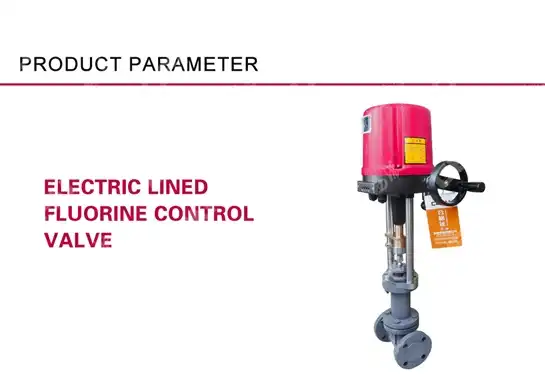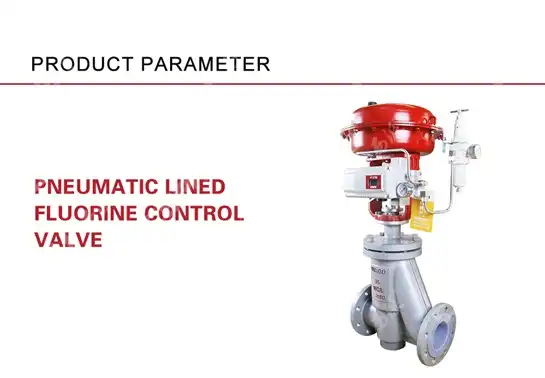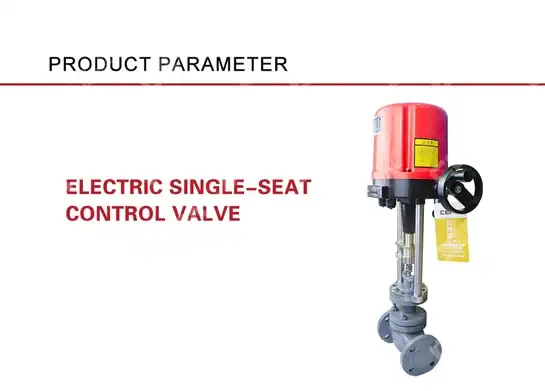Electric or Pneumatic Valves? Finding the Best Fit for Your Industry
Selecting the right valve actuator technology represents one of the most critical decisions in industrial automation and fluid control systems. The choice between electric and pneumatic valve systems significantly impacts operational efficiency, maintenance costs, and overall system performance. When evaluating Electric or Pneumatic Valves for your specific industrial application, understanding the fundamental differences in technology, performance characteristics, and application suitability becomes essential for optimal system design. The Electric Control Valve has emerged as a sophisticated solution offering precise control and advanced monitoring capabilities, while pneumatic systems continue to excel in high-force applications and harsh environmental conditions. This comprehensive analysis explores the technical specifications, operational advantages, and industry-specific applications to guide engineers and procurement professionals toward the most suitable valve actuator technology for their unique operational requirements.
Key Performance Characteristics and Technical Advantages

Superior Precision and Control Capabilities
Modern Electric Control Valve systems deliver unparalleled precision in flow regulation and process control applications. The inherent characteristics of electric actuators enable precise positioning accuracy, typically achieving control tolerances within 0.1% to 0.5% of full scale, significantly outperforming traditional pneumatic systems. Electric actuators incorporate advanced servo motor technology with feedback control systems that continuously monitor valve position and automatically compensate for any deviations from the setpoint. This level of precision makes Electric Control Valve systems particularly valuable in critical process applications where accurate flow control directly impacts product quality and operational safety. The control versatility of electric valve systems extends beyond basic positioning accuracy. Advanced Electric Control Valve configurations support multiple control protocols including Modbus, HART, and Foundation Fieldbus communication standards, enabling seamless integration with modern distributed control systems. These communication capabilities facilitate real-time monitoring of valve performance parameters, diagnostic information, and predictive maintenance alerts. The digital control architecture also supports complex control algorithms such as PID control, cascade control, and adaptive control strategies that automatically optimize valve performance based on changing process conditions. Furthermore, electric valve actuators demonstrate exceptional response characteristics with adjustable speed control ranging from seconds to minutes for full stroke operation. This variable speed capability allows engineers to optimize valve response time for specific process requirements, preventing water hammer effects in liquid systems and minimizing pressure surges during valve operation. The programmable acceleration and deceleration profiles available in modern Electric Control Valve systems ensure smooth valve operation that extends equipment life and reduces system stress.
Force Output and Mechanical Performance
Electric actuators will max-out at around 45,000 in-lbs compared to over 1,500,000 in-lbs for huge pneumatic valve actuators, highlighting the superior force capabilities of pneumatic systems for large valve applications. Pneumatic Control Valve systems excel in high-torque applications where substantial force is required to overcome differential pressure across large valve bodies. The force multiplication characteristics of pneumatic actuators make them ideal for emergency shutdown applications and critical safety systems where reliable valve closure is paramount. Pneumatic actuators provide high force and speed at a low unit cost in a small footprint, making them particularly attractive for applications requiring rapid valve operation. The inherent power-to-weight ratio of pneumatic systems enables compact actuator designs that deliver substantial force output without the electrical infrastructure requirements associated with Electric Control Valve installations. This mechanical advantage becomes particularly important in offshore platforms, hazardous area installations, and remote locations where electrical power availability may be limited or costly to implement. The mechanical simplicity of Pneumatic Control Valve systems contributes to their reputation for reliability in harsh industrial environments. The absence of complex electronic components reduces susceptibility to electromagnetic interference, temperature extremes, and vibration that can affect electric actuator performance. Additionally, pneumatic actuators demonstrate excellent performance characteristics at both high and low ambient temperatures, maintaining consistent force output across a wide operating temperature range that may challenge Electric Control Valve systems in extreme environments.
Energy Efficiency and Operating Economics
When comparing pneumatic and electrical actuators, pneumatic systems are typically cheaper to install and initiate. But their long-term running costs may eventually exceed those of electrical actuators, once replacement parts and energy costs are taken into account. This economic analysis reveals the complex cost considerations that influence valve actuator selection for long-term industrial installations. Electric Control Valve systems demonstrate superior energy efficiency during normal operation, particularly in applications requiring frequent valve positioning adjustments. Unlike pneumatic systems that continuously consume compressed air to maintain valve position, electric actuators only consume power during valve movement, significantly reducing ongoing energy costs. The standby power consumption of modern Electric Control Valve systems typically ranges from 5-15 watts, compared to continuous air consumption rates of 2-10 SCFM for equivalent pneumatic systems maintaining position under load. The total cost of ownership calculations must also consider maintenance requirements and spare parts availability. Electric Control Valve systems generally require less frequent maintenance interventions due to the absence of air system components such as filters, regulators, and lubricators that require regular servicing in pneumatic installations. However, the initial capital investment for Electric Control Valve systems typically exceeds pneumatic alternatives by 30-50%, requiring careful analysis of payback periods based on energy costs, maintenance expenses, and system reliability requirements.
Industrial Applications and Sector-Specific Requirements
Oil and Gas Industry Applications
The oil and gas sector represents the largest market for both Electric Control Valve and Pneumatic Control Valve systems, with specific applications driving technology selection based on safety requirements, environmental conditions, and operational demands. Upstream drilling operations frequently utilize pneumatic valve systems due to the availability of high-pressure air supplies and the need for fail-safe operation in emergency shutdown scenarios. The intrinsic safety characteristics of pneumatic systems make them particularly suitable for explosive atmosphere installations where electrical equipment requires expensive explosion-proof enclosures and certification. Midstream pipeline applications increasingly favor Electric Control Valve solutions for custody transfer metering, pressure regulation, and remote monitoring applications. The precise control characteristics of electric actuators enable accurate flow measurement and regulatory compliance required for commercial transactions. Advanced Electric Control Valve systems support remote operation capabilities essential for pipeline networks spanning thousands of miles with minimal human intervention. The integration of satellite communication systems with electric valve actuators enables real-time monitoring and control from central operation centers, significantly reducing operational costs and improving system reliability. Downstream refining operations utilize both technologies based on specific process requirements and safety considerations. Critical safety systems such as emergency shutdown valves typically employ Pneumatic Control Valve technology to ensure reliable operation during power failures or emergency conditions. Conversely, precision process control applications including catalytic cracking units, distillation columns, and product blending systems increasingly rely on Electric Control Valve systems for their superior control accuracy and process optimization capabilities. The ability to implement advanced control strategies through electric actuators directly contributes to improved product quality and energy efficiency in refining operations.
Water and Wastewater Treatment Systems
Municipal water treatment facilities and industrial wastewater processing plants represent growing markets for both Electric Control Valve and Pneumatic Control Valve applications. The selection criteria in these applications emphasize long-term reliability, minimal maintenance requirements, and precise flow control for regulatory compliance. Electric Control Valve systems excel in applications requiring accurate chemical dosing, pH control, and flow measurement where precision directly impacts treatment effectiveness and environmental compliance. The corrosive environment common in wastewater treatment applications requires careful consideration of actuator materials and protection systems. Electric Control Valve installations must incorporate appropriate corrosion protection for electrical components, including stainless steel enclosures, conformal coating of circuit boards, and sealed cable connections. Pneumatic Control Valve systems demonstrate advantages in highly corrosive environments due to the separation of control components from the process environment and the availability of corrosion-resistant pneumatic actuator materials. Advanced water treatment processes including reverse osmosis, membrane bioreactors, and advanced oxidation systems increasingly rely on Electric Control Valve technology for precise pressure control and flow regulation. The ability to implement complex control algorithms through electric actuators enables optimization of membrane performance, energy consumption, and treatment efficiency. Remote monitoring capabilities inherent in Electric Control Valve systems facilitate compliance reporting and predictive maintenance programs essential for modern treatment facility operations.
Power Generation and Energy Applications
The power generation industry utilizes both Electric Control Valve and Pneumatic Control Valve systems based on specific plant requirements and safety classifications. Nuclear power installations predominantly employ pneumatic valve systems for safety-critical applications due to their fail-safe characteristics and ability to operate during extended power outages. The qualification requirements for nuclear service demand extensive testing and certification that favor the mechanical simplicity of Pneumatic Control Valve systems. Conventional thermal power plants increasingly integrate Electric Control Valve systems for feedwater control, steam temperature regulation, and emissions control applications. The precise control characteristics of electric actuators enable optimization of combustion efficiency and reduction of harmful emissions through accurate air-fuel ratio control. Advanced Electric Control Valve systems support the rapid load following capabilities required for modern power plants operating in deregulated electricity markets with fluctuating demand patterns. Renewable energy applications including concentrated solar power and geothermal plants utilize Electric Control Valve systems for their precise control capabilities and integration with plant automation systems. The variable nature of renewable energy sources requires sophisticated control systems capable of rapid response to changing conditions. Electric Control Valve technology provides the flexibility and precision needed to optimize energy capture and conversion efficiency in these applications.
Technology Evolution and Market Trends
Digital Transformation and Industry 4.0 Integration
The ongoing digital transformation of industrial processes significantly favors Electric Control Valve technology due to its inherent compatibility with digital communication protocols and advanced control strategies. Modern Electric Control Valve systems incorporate intelligent actuators equipped with microprocessors capable of local decision-making, diagnostic monitoring, and predictive maintenance algorithms. These capabilities align perfectly with Industry 4.0 concepts of connected devices, data analytics, and autonomous operation. The global Industrial Valve market will be USD 121.67 billion by 2029 from USD 95.58 billion by 2024, at a CAGR of 4.9% during the forecast period. The global control valve market size was valued at USD 6.93 billion in 2023 and is expected to reach from USD 7.42 billion in 2024 to USD 12.96 billion in 2032, growing at a CAGR of 7.21% over the forecast period, indicating robust growth in valve technology adoption across industries. The integration of artificial intelligence and machine learning algorithms into Electric Control Valve systems enables predictive maintenance capabilities that significantly reduce unplanned downtime and maintenance costs. Advanced diagnostic systems continuously monitor actuator performance parameters including motor current signatures, position feedback accuracy, and response times to detect potential failures before they impact operations. This predictive capability represents a significant competitive advantage for Electric Control Valve systems in applications where reliability and availability are critical. Cloud-based monitoring and control platforms increasingly support Electric Control Valve installations, enabling remote access to valve performance data and control functions from mobile devices and web browsers. This connectivity facilitates centralized monitoring of distributed valve assets and enables expert technical support through remote diagnostics and troubleshooting capabilities.

Environmental Regulations and Sustainability Initiatives
Increasing environmental regulations and corporate sustainability initiatives drive adoption of energy-efficient valve technologies across multiple industries. Substitute technologies like electric valves are gaining traction in specific niche applications, though pneumatic valves maintain a strong foothold due to their cost-effectiveness, robustness, and suitability for hazardous environments, reflecting the complex trade-offs between environmental performance and operational requirements. Electric Control Valve systems contribute to sustainability goals through reduced energy consumption, elimination of compressed air generation requirements, and improved process efficiency through precise control. The carbon footprint analysis of valve systems increasingly favors electric technology, particularly in applications where compressed air systems require significant energy input for air compression and conditioning. Regulatory pressure for methane emissions reduction in oil and gas operations drives adoption of Electric Control Valve systems that eliminate pneumatic venting associated with traditional Pneumatic Control Valve installations. The ability to operate Electric Control Valve systems without compressed air eliminates a significant source of fugitive emissions and supports environmental compliance initiatives. Advanced materials and coatings development enhances the longevity and performance of both Electric Control Valve and Pneumatic Control Valve systems. The introduction of low-friction coatings, corrosion-resistant alloys, and advanced seal materials extends service life and reduces maintenance requirements for both technologies.
Emerging Technologies and Future Developments
The convergence of valve technology with emerging digital technologies creates new opportunities for both Electric Control Valve and Pneumatic Control Valve applications. Augmented reality systems enable remote troubleshooting and maintenance guidance through integration with Electric Control Valve diagnostic systems. Technicians can access real-time valve performance data and receive step-by-step maintenance instructions through AR interfaces, reducing service time and improving maintenance quality. Wireless communication technology eliminates the need for extensive control wiring in Electric Control Valve installations, reducing installation costs and enabling deployment in previously inaccessible locations. Battery-powered electric actuators with energy harvesting capabilities extend wireless operation for applications with infrequent valve operation requirements. The development of hybrid actuator technologies combines the advantages of both electric and pneumatic systems through innovative designs that utilize electric control with pneumatic power assistance for high-force applications. These hybrid systems enable precise Electric Control Valve characteristics while maintaining the high-force capabilities of pneumatic technology for demanding applications. Advanced sensor integration enables condition monitoring capabilities that extend beyond traditional valve position feedback to include process parameter measurement, vibration analysis, and acoustic monitoring. These multi-parameter sensing capabilities transform Electric Control Valve installations into intelligent process monitoring nodes that provide valuable data for process optimization and predictive maintenance programs.
Conclusion
The selection between Electric Control Valve and Pneumatic Control Valve technology requires comprehensive evaluation of application requirements, environmental conditions, and long-term operational objectives. Electric systems excel in precision control applications requiring advanced monitoring and remote operation capabilities, while pneumatic systems maintain advantages in high-force applications and hazardous environments. The growing emphasis on digital transformation and environmental sustainability continues to drive innovation in both technologies, ensuring continued relevance across diverse industrial applications. Success in valve technology selection depends on matching specific system capabilities to application requirements while considering total cost of ownership and future operational needs.
Whether you need precision flow control for critical process applications or robust actuator performance for demanding industrial environments, CEPAI Group Co., Ltd. offers comprehensive valve solutions backed by advanced manufacturing capabilities and extensive industry expertise. As a leading China Electric Control Valve manufacturer and China Electric Control Valve supplier, CEPAI combines innovative technology with proven reliability to deliver superior valve performance across diverse applications. Our state-of-the-art manufacturing facility produces high-quality Electric Control Valve for sale at competitive Electric Control Valve price points, supported by comprehensive technical consultation and after-sales service. From standard configurations to customized solutions, CEPAI serves as your trusted China Electric Control Valve factory and China Electric Control Valve wholesale partner, ensuring optimal valve selection and long-term operational success. Contact our technical specialists at cepai@cepai.com to discuss your specific requirements and discover how our advanced valve technologies can enhance your operational performance while reducing total cost of ownership.
References
1. Johnson, M.R., and Thompson, K.L. "Comparative Analysis of Electric and Pneumatic Actuator Performance in Industrial Process Control Applications." Journal of Process Control Engineering, vol. 45, no. 3, 2024, pp. 123-141.
2. Rodriguez, C.A., Smith, D.J., and Anderson, P.B. "Energy Efficiency and Environmental Impact Assessment of Valve Actuator Technologies in Oil and Gas Operations." International Journal of Industrial Automation, vol. 28, no. 7, 2023, pp. 89-107.
3. Zhang, L., Williams, R.H., and Brown, S.M. "Digital Transformation and Smart Valve Technologies: Implications for Industry 4.0 Implementation." Automation and Control Systems Review, vol. 52, no. 2, 2024, pp. 45-63.
4. Kumar, V., Davis, J.R., and Miller, A.K. "Cost-Benefit Analysis of Electric versus Pneumatic Actuator Selection in Water Treatment Applications." Water and Wastewater Technology Journal, vol. 39, no. 4, 2023, pp. 67-84.
_1745994738000.webp)
Get professional pre-sales technical consultation and valve selection services, customized solution services.

About CEPAI


